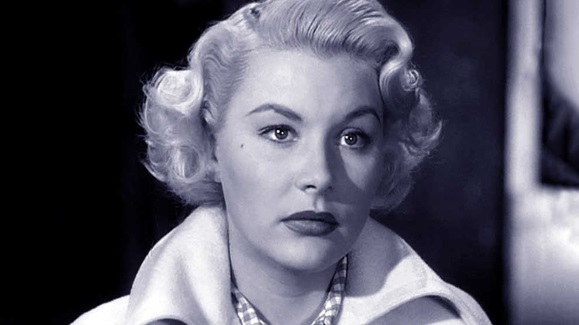The Four Sided Triangle
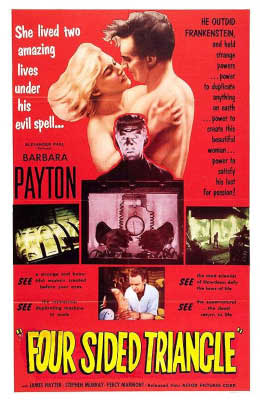
Director: Terence
Fisher
Year: 1953
Rating: 5.0
Four Sided Triangle is a poorly budgeted drab
black and white film that leaves a bit of a bitter taste in your mouth today,
but it is important in that it was Hammer's first venture into the genre
of sci-fi and was directed by Terence Fisher. At the time Hammer was primarily
producing black and white noir and suspense films in co-operation with the
American Lippert Company. The film is based on a 1949 novel from William
Temple but which first appeared in a shorter version in a 1939 issue of Amazing
Stories. Hammer wasn't willing to put much money in the film and Fisher was
a reliable director that they had hired for the crime film Wings of Desire
and the noir melodrama Stolen Face - both shot in 1952. This film must have
done well enough because later in the year Hammer produced Spaceways, another
sci-fi film that at least looks to have a higher budget. That was also directed
by Fisher. Later of course he directed the sacred triad of famous Hammer
Horror films - The Curse of Frankenstein, Dracula and The Mummy. He
should have his own statue next to Nelson's Column in Trafalgar Square.
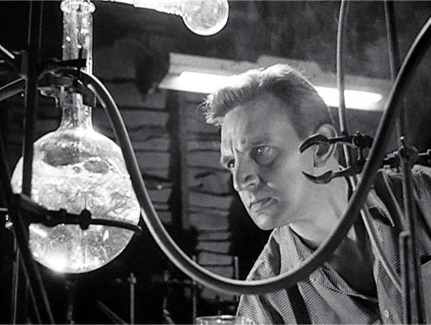
A film bookended by scripture is never a
good sign and this film asks big questions about what it is to be human.
Its answer is a bit creepy and queasy. But basically the lesson is that man
should not play God but of course we do all the time beginning with the nuclear
age and into life-saving medicine and cloning. And in films the Mad Scientist
thinking he is God is a long recurring theme. Our Mad Scientist in this film
isn't the usual rolling eyed frothing performance but all the same his obsession
if looked at objectively is insane and truly playing God. And never really
thinking of the consequences. Besides on a personal level, the world's economy
would crash, work would become pointless. Of course, that might be a good
thing. Nearly everyone in the film in fact if judged objectively has lost
their mind.
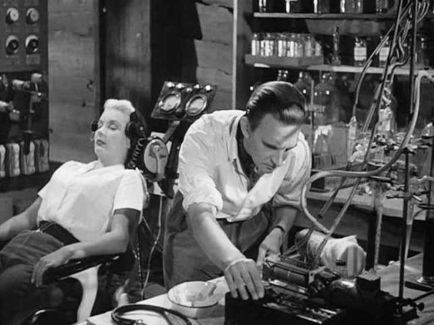
It begins with a three-sided triangle as
children and is narrated by the town doctor played by James Hayter - who
is a favorite British character actor of the period (Pickwick Papers).
Bill and Robin are the best of friends as children and Lena is their glue
holding all three together. They joust for her honor and as she watches and
smiles gleefully you know this will not end well. Years later Bill and Robin
are brilliant scientists working on an invention that could change the world.
In their garage with a bunch of test tubes and wires. They call it a Reproducer
and through electrons and electricity and gobbledygook, it can duplicate
anything. They do it with the doctor's watch, a check and the ramifications
are enormous. Lena now as Barbara Payton looking like a Jean Harlow reproduction
has returned from being away and immediately thinks of gold and diamonds.
The men (now Stephen Murray and John Van Eyssen) think of reproducing enough
medicine for the whole world. Of course, the government wants to own it once
they are informed of it.
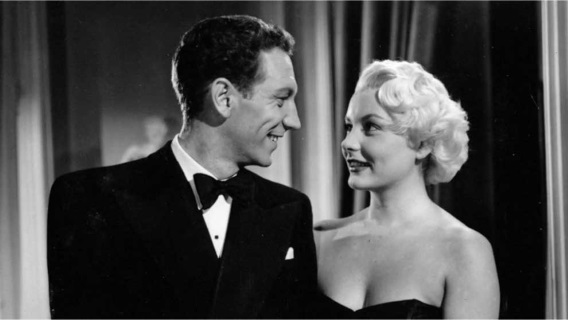
Then the inevitable happens - both men are
in love with Lena and always have been. She chooses Robin, the rich one and
Bill is heart-broken. What can he do? Take up drinking? Find another woman?
No. He has this Reproducer machine. What if? Yes, make another Lena and this
one will love me. Why? Because I gave her life. But with the same memories
and feelings as Lena. A man's fantasy. I would make another Taylor Swift
and certainly she would love me. Right? Having another one of me would just
be creepy - having to share my Social Security would be a problem. In the
book, the second Lena was named Dolly - the name of the first cloned sheep.
American actress Payton's life story would make a more exciting film than
this one. One of excess in men, alcohol and drugs. You name an actor from
that period and she likely had an affair with him. Franchot Tone and Tom
Neal got into a fistfight over her that put Tone into a coma. Her career
that at one time was bringing in $5,000 a week crashed and burned - she died
in 1967 at 39-years-old from liver failure. Another Hollywood car wreck.
